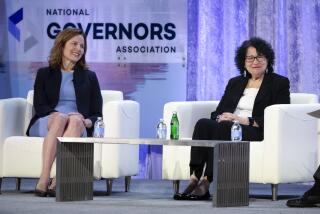Supreme Court nominee Sonia Sotomayor rose from humble roots
- Share via
WASHINGTON — For a teenager from a Puerto Rican family struggling upward from the public housing projects of the Bronx, Princeton University in 1972 was a foreign land. “I felt isolated from all I had ever known,” she said later, and the low grade she got on one of her first papers drove home the point -- sending her flying to get remedial help.
Four years later, Sonia Maria Sotomayor won the Pyne Prize, the highest honor awarded a Princeton undergraduate. Three years after that, she was the editor of the Yale Law Journal.
Born amid poverty, raised by her mother after her father died when she was a child, diagnosed with juvenile diabetes, the first Latino ever nominated to the Supreme Court has a life story that embodies some of the nation’s most enduring values.
“The kid who didn’t know how to write her first semester was honored for her academic excellence and commitment to university service with that award,” she said in 2002. “In my years there, Princeton taught me that people of color could not only survive there, but that we could flourish and succeed.”
As President Obama began sifting through possible choices for his first nomination to the high court, he announced that intellectual distinction would be important, but so would a capacity for empathy -- an ability to apply the lessons of experience to abstruse legal issues that could touch the lives of ordinary people.
On that basis, it’s not hard to see how he settled on Sotomayor. In many ways, her life echoes the president’s own. Like Obama, she was raised by a single mother. And as Obama said in nominating her Tuesday, “she has never forgotten where she began, never lost touch with the community that supported her.”
Sotomayor, 54, is poised to succeed beyond even her wildest hopes in 1972. At that time, the high court was the province of white males. Even now, if she is confirmed by the Senate, she would become only the third woman and the third minority to serve as a justice.
Described as warm, humble and unassuming, with little inclination to promote herself, Sotomayor beat out several more established candidates for the court. “She’s not someone who has risen up to a place of power and surrounds herself with other people of power,” said Julia Tarver Mason, a former clerk.
As both a district court judge and on the appeals court, Sotomayor made a conspicuous effort to reach out to clerks, secretaries -- every worker in the courthouse.
She “knows all of the doormen. She knows all the cafeteria workers. Knows all the janitors,” said Robin Kar, a former clerk and now a law professor at the University of Illinois. “She does understand poverty. She does understand people from all walks of life.”
In her youth, Sotomayor had no desire to be a judge. Inspired by Nancy Drew books, she longed to be a police officer or a detective. A diabetes diagnosis when she was 8 altered that equation and moved her to pursue a more sedate career. (She also found inspiration watching “Perry Mason.”) A year later, her father died.
Her parents had arrived in New York from Puerto Rico during World War II, and Sotomayor had grown up in a close-knit world where Spanish was the spoken language. She didn’t grow comfortable with English until after her father’s death.
By then, her mother, Celina, a nurse at a methadone clinic, was working day and night on a mission to send Sotomayor and her brother, Juan, now a doctor, to a private Catholic high school in the Bronx. “Sonia’s mom bought the only set of encyclopedias in the neighborhood,” Obama noted.
“My mother has devoted her life to my brother and me,” Sotomayor said at the White House. “She worked often two jobs to help support us after Dad died. I have often said I am who I am because of her, and I am only half the woman she is.”
After graduation from Yale in 1979, and when many of her peers began lucrative careers in the private sector, Sotomayor became a prosecutor, working for venerable Manhattan Dist. Atty. Robert Morgenthau. She rose quickly from junior to senior assistant district attorney, moving from prosecuting misdemeanors to felonies.
“She was right out of law school,” said John W. Fried, who was Sotomayor’s supervisor. “And what impressed me was her ability to move almost seamlessly from studying law from law books to being an assistant D.A. in a large urban environment -- with legal issues and factual issues that are not the subject of any law school curriculum.”
She later moved on to a Manhattan law firm, where she became a partner. But it wasn’t long before President George H.W. Bush, a Republican, in a deal with New York Democratic Sen. Daniel Patrick Moynihan, named her to be a U.S. District Court judge for the Southern District of New York, one of the nation’s busiest courts. She was the first Latina on the court.
In an interview at the time, she spoke of the courts as the “last refuge for the oppressed.”
“I’m a down-to-earth litigator,” she said, “and that’s what I expect I’ll be like as a judge.”
President Clinton picked her for the 2nd Circuit in 1997, but Republicans in the Senate dragged out her nomination, fearing that the appointment would pave the way for a Supreme Court nomination. She was confirmed in 1998.
For Sotomayor, who is divorced with no children, her clerks functioned as a sort of surrogate family.
Judge Guido Calabresi, a fellow judge on the 2nd Circuit Court who taught the young Sotomayor torts at Yale, said she was the one who organized dinners for the judges on the court and their spouses.
But he was also quick to praise her for her work on the bench. “She’s always a very forceful and powerful judge,” Calabresi said. “She has, not on an insignificant number of occasions, caused me to change my mind. I would read one of the memos she had written on a case and say, ‘I think she’s got it and I don’t.’ ”
Fried compared Sotomayor to the late Justice Byron White. “I once had a beer with Whizzer White,” Fried said. “He was just a down-to-earth guy. She very much reminded me of that. Unpretentious. A humble-type person who through hard work and effort was given a great opportunity.”
--
Andy Zajac of the Washington bureau contributed to this report.
--
(BEGIN TEXT OF INFOBOX)
Sonia Sotomayor
Age: 54
Born: New York City
Experience: Judge, 2nd U.S. Circuit Court of Appeals, 1998-present. Judge, U.S. District Court, Southern District of New York, 1992-98. Private practice, New York City, 1984-92. Assistant district attorney, New York County, 1979-84
Education: B.A., Princeton University, 1976; J.D., Yale Law School, 1979
Family: Divorced; no children
Quote: “I don’t believe we should bend the Constitution under any circumstance. It says what it says. We should do honor to it.”
-- From a 1997 nomination hearing
Source: Associated Press
More to Read
Get the L.A. Times Politics newsletter
Deeply reported insights into legislation, politics and policy from Sacramento, Washington and beyond. In your inbox twice per week.
You may occasionally receive promotional content from the Los Angeles Times.










